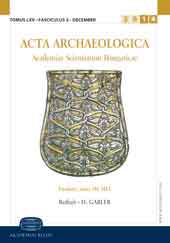A bronze figurine of Minerva discovered at Apulum
A bronze figurine of Minerva discovered at Apulum
Author(s): Radu Ota, Adrian Cosmin BologSubject(s): Archaeology
Published by: Akadémiai Kiadó
Keywords: bronze figurine; the southern cemetery; Minerva; municipium Septimium Apulense
Summary/Abstract: The authors discuss herein, and present the specialists, a recent find related to the classical Graeco-Roman pantheon. It is a bronze figurine of Minerva discovered in a waste pit from the southern cemetery of the urban centre at Apulum, located on the Furcilor Hill-“Podei”. Although archaeology records no workshop making such pieces, this figurine, rather modest in artistic terms, had likely been produced at Apulum or in one of the workshops from the Roman province of Dacia. It is a solid cast, in the “lost-form” technique, sized as follows: height – 7.2 cm, width – 1.9 cm, thickness – 0.9 cm. On the basis of its execution, which lacks accurate rendering of facial features, yet also the absent Gorgon on the aegis, the votive figurine may be dated to the 3rd century AD. Since it was not discovered in a grave, but in a waste pit, it is rather difficult to make a connection with any possible funerary function of the goddess. The ancient prototype of this kind of representation is the cult statue of Athena Parthenos of Phidias, housed on the Acropolis of Athens. The other six bronze votive figurines of Minerva discovered in Dacia do not resemble that discussed here.
Journal: Acta Archaeologica Academiae Scientiarum Hungaricae
- Issue Year: 70/2019
- Issue No: 2
- Page Range: 317-323
- Page Count: 7
- Language: English
- Content File-PDF

